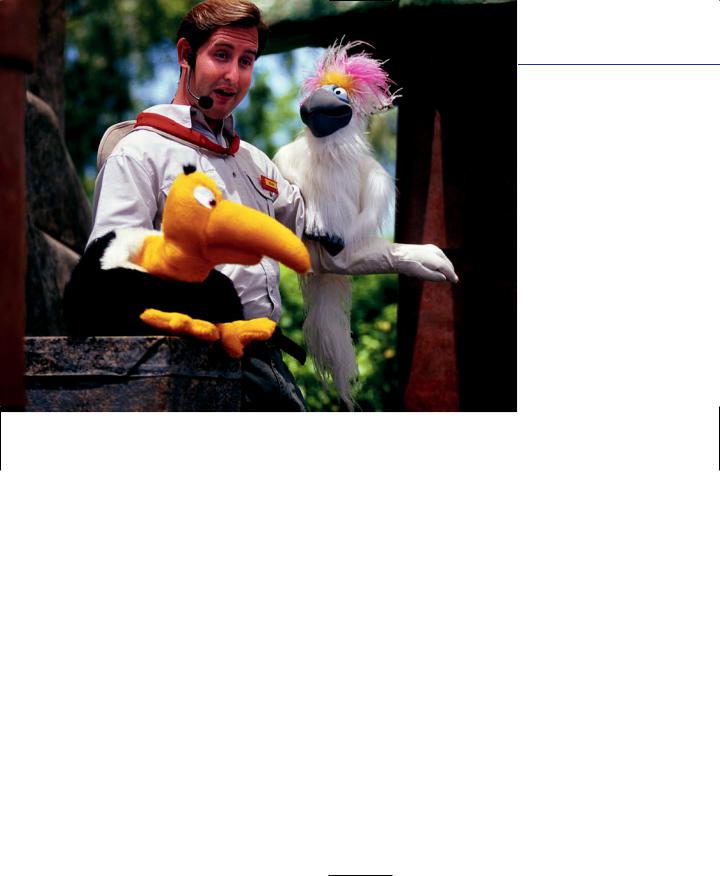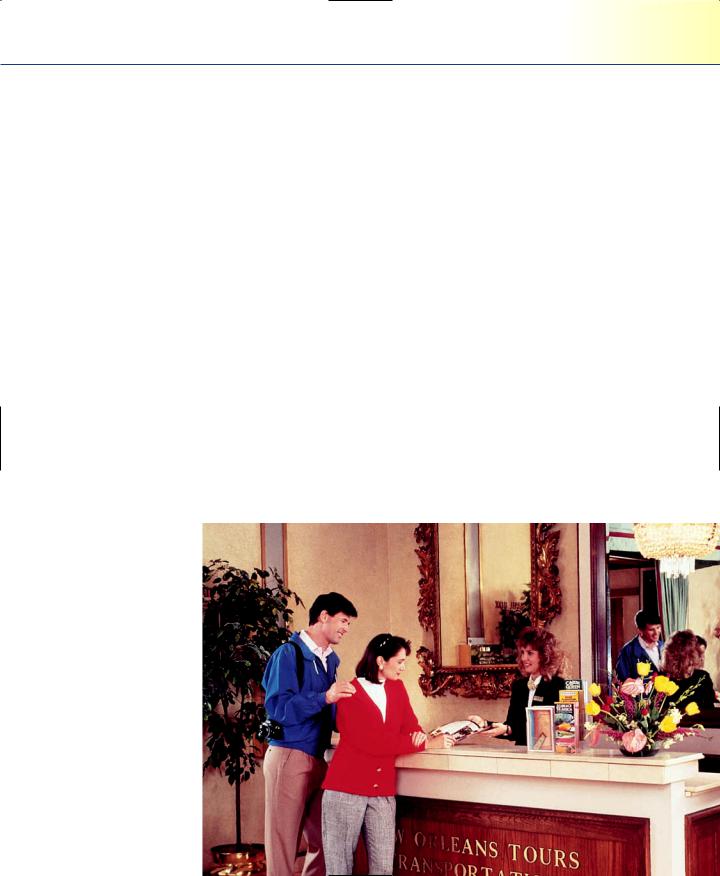
- •CONTENTS
- •PREFACE
- •Content—Benefits for Students
- •Content—Benefits for Instructors
- •Features of the Book for Students and Instructors
- •Supplementary Materials
- •Acknowledgments
- •What Is Hospitality Management?
- •The Manager’s Role in the Hospitality Industry
- •Why Study in a Hospitality Management Program?
- •Planning a Career
- •Employment as an Important Part of Your Education
- •Getting a Job
- •Employment at Graduation
- •The Outlook for Hospitality
- •Summary
- •Managing Change
- •Demand
- •Supply
- •Workforce Diversity
- •The Impact of Labor Scarcity
- •Summary
- •The Varied Field of Food Service
- •The Restaurant Business
- •The Dining Market and the Eating Market
- •Contemporary Popular-Priced Restaurants
- •Restaurants as Part of a Larger Business
- •Summary
- •Restaurant Operations
- •Making a Profit in Food Service Operations
- •Life in the Restaurant Business
- •Summary
- •Chain Restaurant Systems
- •Independent Restaurants
- •Franchised Restaurants
- •Summary
- •Competitive Conditions in Food Service
- •The Marketing Mix
- •Competition with Other Industries
- •Summary
- •Self-Operated Facilities
- •Managed-Services Companies
- •Business and Industry Food Service
- •College and University Food Service
- •Health Care Food Service
- •School and Community Food Service
- •Other Segments
- •Vending
- •Summary
- •Consumer Concerns
- •Food Service and the Environment
- •Technology
- •Summary
- •The Evolution of Lodging
- •Classifications of Hotel Properties
- •Types of Travelers
- •Anticipating Guest Needs in Providing Hospitality Service
- •Service, Service, Service
- •Summary
- •Major Functional Departments
- •The Rooms Side of the House
- •Hotel Food and Beverage Operations
- •Staff and Support Departments
- •Income and Expense Patterns and Control
- •Entry Ports and Careers
- •Summary
- •The Economics of the Hotel Business
- •Dimensions of the Hotel Investment Decision
- •Summary
- •The Conditions of Competition
- •The Marketing Mix in Lodging
- •Product in a Segmented Market
- •Price and Pricing Tactics
- •Place—and Places
- •Promotion: Marketing Communication
- •Summary
- •The Importance of Tourism
- •Travel Trends
- •The Economic Significance of Tourism
- •The United States as an International Tourist Attraction
- •Businesses Serving the Traveler
- •Noneconomic Effects of Tourism
- •Summary
- •Motives and Destinations
- •Mass-Market Tourism
- •Planned Play Environments
- •Casinos and Gaming
- •Urban Entertainment Centers
- •Temporary Attractions: Fairs and Festivals
- •Natural Environments
- •On a Lighter Note. . .
- •Summary
- •Management and Supervision
- •The Economizing Society
- •The Managerial Revolution
- •Management: A Dynamic Force in a Changing Industry
- •What Is Management?
- •Summary
- •Why Study Planning?
- •Planning in Organizations
- •Goal Setting
- •Planning in Operations
- •The Individual Worker as Planner
- •Long-Range Planning Tools
- •Summary
- •Authority: The Cement of Organizations
- •Departmentalization
- •Line and Staff
- •Issues in Organizing
- •Summary
- •Issues in Human-Resources Management
- •Fitting People to Jobs
- •Recruiting
- •Selection and Employment
- •Training
- •Retaining Employees
- •Staff Planning
- •Summary
- •The Importance of Control
- •Control and the “Cybernetic Loop”
- •Tools for Control
- •Summary
- •Leadership as Viewed by Social Scientists
- •Why People Follow
- •Leadership Theories
- •Communication
- •The Elements of Leading and Directing
- •Developing Your Own Leadership Style
- •Summary
- •A Study of Service
- •Rendering Personal Service
- •Managing the Service Transaction
- •How Companies Organize for Service
- •Summary
- •INDEX

654 |
Chapter 21 The Role of Service in the Hospitality Industry |

 TABLE
TABLE 21.1
21.1

























































Three Types of Service Transactions



















TYPE OF INTERACTION |
EXAMPLE |
KEY POINTS |
Mechanical- |
TV check- |
Acceptable, if it eliminates inconvenience. |
electronic |
out |
Failure is unacceptable to guest, so |
|
|
plan should be error-free. |
Indirect |
Telephone |
Detailed scripting desirable so that |
|
contacts |
each customer receives the same |
|
|
level of service. |
|
Housekeeping |
General procedure must be specified |
|
|
and replicated in each and every room. |
Face-to-face |
Guest registration |
Person assisting the guest |
|
at the front desk |
represents the organization. |
Rendering Personal Service
Service involves “helpful, beneficial, or friendly action or conduct.”5 As we have just noted, some of these actions are provided by electronic, mechanical, or computerized devices or involve only indirect personal contact, usually by e-mail or phone. The most challenging service area involves helping that is performed person to person. There are two basic aspects to the personal service act: that of the task, which calls for technical competence, and that of the personal interaction between guest and server, which requires what we can sum up for now as a helpful or friendly
attitude (Figure 21.2).
TASK
As recently as the late 1980s, the hospitality industry’s ideas on personal service as expressed in training programs and server manuals focused principally on procedure. Such training procedures tended to focus on how to carry trays, how to hold plates, the correct side of the guest from which to serve, and so on. Functional (or procedural) task competence is still an essential element in any service action. Guests don’t want a thumb in their soup any more than they want a bellperson to get lost rooming them—-or a front desk that can’t find their reservation. The emphasis has changed, or is changing, however.
In modern service organizations, the task side of service is controlled by management through carefully developed systems that are supported by written procedures.

Rendering Personal Service |
655 |
Guest
INTERPERSONAL
ASPECT
Provides helpful, friendly attitude
Helping skills
Provides competent performance
Procedures
Details
TASK
ASPECT
Server
Figure 21.2
Two aspects of service.
Procedures of this kind control work in very much the same way that a carefully designed assembly line controls the way goods are manufactured.
As one authority on the study of services put it, “In real estate, the three components of successful investing have always been location, location, and location. In service encounter management, the components for success might be stated as details, details, details.”6 If a service organization is failing, blaming the employee is a cop-out. Getting the procedures right and a proper system functioning is the task of management.
Although there is no substitute for accomplishing the task of service competently, that alone is seldom enough to secure repeat business in a highly competitive marketplace.
INTERPERSONAL SKILLS
The other aspect of personal service involves the way in which the server (or desk clerk, etc.) approaches and deals with the guest. Perhaps the best model for thinking about the kind of behavior that secures a favorable response from the guest is that of “helping skills.” These were originally derived from studying the working techniques of psychotherapists. The helping skills have now been simplified into a technique for

Both technical competence and good interpersonal skills are important to personal service. (Courtesy of LEGOLAND® CALIFORNIA.)
anyone whose work involves interacting with people. In fact, methods for its use have been developed for a wide variety of “people workers,” ranging from police to college residence hall proctors and nurse’s aides. All have in common that they are “people helpers” and provide services to people.
The core conditions of a friendly and helpful attitude can be spelled out more fully. Servers need to be able to put themselves in the other person’s shoes; in a word, they need empathy. They need to present a friendly face to the guest and to do so in a way that is not going to be seen as just an act; they need to be (or at least appear) sincere.
Professionals who understand the skills that underlie successful interpersonal behavior assume that things such as eye contact, facial expression, hand movements, and body language generally are learned skills and, hence, readily teachable. For instance, such tactics as making eye contact with the guest send the message that the server is interested in communication and assisting.
Thus, employees must learn not just to have an attitude that is helpful and friendly to the guest but to convey that attitude to the guest by their behavior. Excellent interpersonal behavior is characterized by warmth and friendliness and a manner that imparts to the guest a sense of being in control—-or the sense of being in the charge of someone who knows very well what he or she is doing.
656

Managing the Service Transaction |
657 |
Managing the Service Transaction
Most work done in the hospitality industry has the focused activity of a single process and can be supervised by someone who can keep track of what is going on. For instance, food preparation in a kitchen is organized around the process
of cooking, usually following written recipes. If the food is acceptable, the process is being managed correctly. Hospitality service, on the other hand, is made up of transactions that are numerous, diverse, and often private. In a dining room each interaction between a server and a guest is really something just between the two of them— or, at most, between the server and the guest’s party at that table. A multitude of these transactions are taking place in the dining room over the period of a single meal. The problems of managing this process are made more complex by the fact that the product is the guest’s experience. The problem of producing a favorable feeling about an operation in numerous guests is too complex for any management to control in any detail.
Two somewhat different basic approaches to this challenge of managing service have developed.7 The most common, which we can call the product view of service, focuses on controlling the tasks that make up the service. An increasingly important alternative is the process view of service, which concentrates on the guest-server interaction. The two views are not necessarily mutually exclusive. In practice, some of the elements of control that
underlie the product view are found in any well-run service unit. In addition, attention to the way we treat people—that is, a process orientation—-is necessary in any operation.
THE PRODUCT VIEW OF SERVICE
The product view looks at service as basically just another product that businesses sell to customers. The product view concentrates on rationalizing the service process to make it efficient and cost-effective as well as acceptable to the guest. The focus is on controlling the
Hospitality service is made up of numerous transactions including some that occur out of the sight of the guest. (Courtesy of Four Seasons Hotels.)

658Chapter 21 The Role of Service in the Hospitality Industry
accomplishment of the tasks that make up the service. Employee behaviors that are part of that task are prescribed, often in considerable detail.
Perhaps the best example of the product view of service is McDonald’s and quickservice food generally.8 Theodore Leavitt has described old-style, European service as a process anchored in the past, “embracing ancient, preindustrial modes of thinking,” involving a servant’s mentality and, often, excessive ritual. Leavitt contrasts this with the rationale of manufacturing, where the orientation is toward efficiency and results— and where relationships are strictly businesslike. Leavitt sees the key to McDonald’s success as “the systematic substitution of equipment for people, combined with the carefully planned use and positioning of technology.” In fact, this formula is used by many companies besides McDonald’s.
The quick-service formula for success is a simplified menu matched with a productive plant and operating system designed to produce just one specific product line. Leavitt suggests that giving employees choices in their tasks “is the enemy of order, standardization, and quality.” The classic example of this simplification and automation is the McDonald’s french fry scoop, which permits speed of service and accurate portioning with no judgment or discretion on the part of the employee. A McDonald’s unit, Leavitt says, “is a machine that produces, with the help of totally unskilled machine tenders, a highly polished product.”9
The product view faces obstacles on two different fronts. First, the pool of employees that hospitality service firms draw from shrinks and expands from time to time. In light of the occasional shortage of employees, employers often look for means to make service jobs more attractive. Because many employees prefer to be able to use their own judgment rather than just follow the rules, the close control of behavior required by the product view is increasingly called into question. Perhaps even more significant are guest reactions, particularly in upscale markets.
Widespread application of the product view of service has led guests to “ask where the service has gone from the service industries.” As one writer put it:
Recently, it has been proposed that offering goods and services is not enough, that customers must be provided with an experience. One common theme from the research . . . is the importance of the actual customer-employee encounter, with the focus on the service provider. An often-overlooked element, however, is the role a customer’s perception has in a service exchange, which can have a major effect on the outcomes of the exchange.10
THE PROCESS VIEW: EMPOWERMENT
The product view of service, as we have just noted, sees service as a product that can be controlled efficiently in a production process that is typical of manufacturing. The

Managing the Service Transaction |
659 |
process view, on the other hand, focuses on the interaction between the service organization and the guest.11 The key contrast between the two approaches, as we will view them, is between control and empowerment. The process view of service calls for satisfying the guest’s desires as the first priority. Service employees increasingly are being given the discretion—-that is, empowered—-to solve problems for the guest by making immediate decisions on their own initiative and discussing these later with management. Examples from the experience of Four Seasons, a premier hotel chain, illustrate the kind and degree of impact this approach is having on hospitality companies.12
■A guest ordered a dinner of linguini and clams. When the order came, the dish was divided into white and black (squid ink) linguini. The guest ate the white linguini but left the black half untouched on the plate. The server inquired if the dinner was all right, and the guest responded, “I just don’t like squid ink linguini.” The incident came to light because the guest was a “spotter” employed by a firm retained by Four Seasons to “shop” its hotels and report on the quality of service.
In reviewing the incident, management learned that the description “squid ink linguini” was not indicated on the menu. As the guest had no way of knowing that something she didn’t like was going to be served, the waiter should have removed the charge for this item from the guest’s bill even though she didn’t complain. The waiter did not do so, however, because the property’s accounting procedure would have required a
Empowerment is especially important in situations where the employee is expected to exercise judgment and discretion. (Courtesy of Marriott International.)

660Chapter 21 The Role of Service in the Hospitality Industry
lengthy process and management authorization for taking the charge off the guest check.
As a result of this incident, the property’s accounting rules were changed to make it possible for a server to void an item on a bill immediately and account for that action later. (The menus were also reprinted to identify the squid ink linguini specifically.)
■A guest called the desk and asked to have a fax machine installed in his room. The property did not have a fax machine available for this purpose, but the clerk undertook to rent one from an equipment supply house. Because the supply house required a sizable cash deposit, the clerk asked the guest for the cash.
When the front-office manager learned of this, she told the clerk to pay the deposit out of hotel funds and charge the guest’s account for the “paid out.” She then used this incident to teach not only this clerk but the whole front office as part of the hotel’s constant retraining process to heighten everyone’s sensitivity to the need to solve the guest’s problem with a minimum of inconvenience to the guest and clean up the paperwork later. (The property also added fax machines to the equipment available for guest use.)
■A guest’s reservation had identified a preference for a club floor room with a kingsized bed and an ocean view. When the guest arrived, he found the room had all the requested features but was too small for his working needs. He called the concierge and told him of his problem. Looking at room availability, the concierge indicated he could meet all of the guest’s requirements only with a room that was not on a club floor. That would mean the guest would not have concierge services available. The guest decided to stay where he was. A few minutes later, however, the concierge called the guest back. After studying his reservations, the concierge had been able to juggle some arrivals so as to make a room on the club floor available, one that had the ocean view and adequate space. The concierge offered the guest the room at the same rate although it was an executive suite, which normally carried a higher rate. The concierge was able to do this because of a recent change in procedure giving him the authority to make decisions to satisfy guests—-and account for them later. The guest accepted the concierge’s offer and, not surprisingly, later wrote to compliment the hotel’s management on its superb service.
In these examples, we have seen how one luxury hotel group is trying to make its employees more concerned for the guest. It is changing operating and accounting rules and procedures to help employees do what they have to do to satisfy guests. This is precisely what is meant by the term empowerment.

Managing the Service Transaction |
661 |
Another example is a training program developed at the Cincinnati Marriott Northeast in which a 12-point service program was established for the purpose of “encouraging staff members to treat each guest as though she or he was part of the family and on a visit to your home.” The program entailed employees carrying pledge cards to uphold the principles, energetic staff meetings in which guest service was celebrated, and staff recognition programs.13
PRODUCTION OR PROCESS VIEW?
Some kinds of operations are ideally suited to the production-line approach to service. Quick-service restaurants, amusement parks, and budget motels come to mind as having the need for the cost efficiency of the production approach. Patrons of upscale operations, however, demand the personal attention and individualized service that is facilitated by the process view of service, and midmarket operations are increasingly interested in empowering employees to achieve the competitive advantage that comes from committed service people.
As we noted at the outset of this discussion, some attention must be paid to the quality of personal interchanges in the most bare-bones economy operation. Similarly, basic tasks must be accomplished with competence and dispatch in the most luxurious of operations. It is not a matter of choosing between two different approaches but of adapting each approach to the needs of particular operations. The reliance on rule setting and the product approach is associated with mass-market operations, but we should note that several limited-service hotel chains have built “satisfaction guaranteed” programs for guests around employee empowerment with excellent results. Figure 21.3 summarizes key characteristics of the two views of service discussed.
P R O D U C T V I E W O F S E R V I C E
Emphasizes service as a task Controls employee behavior
Cost of transaction process Objective, measurable standards Concentrates on what we do
P R O C E S S V I E W
O F S E R V I C E
Emphasizes interaction with the guest
Empowers employee to satisfy guest’s needs and desires to solve guest’s problem
Concentrates on what the guest wants
Figure 21.3
Managing the service transaction: two approaches.
